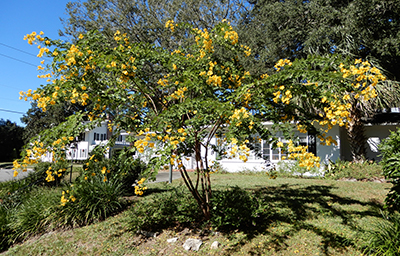Christmas Cassia Causes Confusion
By Marc Frank, Extension Botanist

Senna pendula habit: shrub or small tree with arching branches; UF/IFAS.
As winter approaches in Florida, plant lovers cannot help but notice the golden spectacle of the Christmas cassia (also known as Christmas senna, climbing cassia, or valamuerto). This shrub or small tree bears clusters of showy, bright yellow blossoms, on often-arching branches. Flowering begins as early as mid to late October and in frost-free parts of the state may extend through April, but in most areas peak bloom coincides with the holiday season.
The genera Senna and Chamaecrista were traditionally included in a broadly conceived Cassia. As a result, the names Cassia and Senna are often viewed by gardeners as interchangeable. However, morphological, floral development, and molecular data clearly support the recognition of Cassia, Senna, and Chamaecrista as three distinct genera. Cassia consists of roughly 30 species, all of which are tropical trees. Senna comprises over 300 species, including trees, shrubs, and herbs, which are mostly tropical but extend into temperate regions.
The number and configuration of the stamens (the male organs of the flower) are the best means for distinguishing Cassia and Senna. Cassia species always have 10 stamens, with the 3 lowermost stamens longer than the others and sigmoid (with a distinctive S-shaped curve). Senna species can have anywhere from 2 to 10 stamens, and these are typically shorter and straighter; in some species the lowermost stamens may be curved, but never S-shaped. Also, in Cassia, the petiole (leaf stalk) never bears nectar glands, while in Senna, the petiole commonly bears one or more nectar glands.
Starting as early as 1912, the USDA Office of Foreign Seed and Plant Introduction made repeated imports of the plant we now know as Christmas cassia. Most of the introductions were under the name Cassia bicapsularis—now known as Senna bicapsularis—and that name has stuck with the plant for decades. Subsequent research has shown that almost all of the plant material cultivated under the name Senna bicapsularis is in fact Senna pendula. An examination of herbarium specimens from the University of Florida, University of South Florida, and Fairchild Tropical Botanic Garden suggests that true Senna bicapsularis is quite rare in cultivation in Florida, while Senna pendula is common and widespread.

Senna pendula close-up of flower: notice the elongated pedicels (flower stalks) which readily distinguish it from Senna bicapsularis. UF/IFAS.
Why should we care about this? It turns out that Senna pendula is an invasive threat in Florida. It has been found naturalized (growing in the wild) in over 20 counties in the state.
Based on its predictive tool, the UF/IFAS Assessment of Non-Native Plants in Florida’s Natural Areas indicates that Senna pendula is invasive and not recommended in any region of Florida.
Those of us who love this plant might claim that we are growing the non-invasive Senna bicapsularis, but chances are we are fooling ourselves.
How can you tell if that golden-flowered treasure in your home garden or local demonstration garden is really Senna bicapsularis or the invasive Senna pendula? True Senna bicapsularis has compound leaves typically consisting of 3 pairs of leaflets and the flowers are borne on very short pedicels (stalks) — less than half a centimeter in length. In contrast, Senna pendula has compound leaves with 4 to 7 pairs of leaflets, and the flowers are borne on longer (1 to 3 cm) pedicels.
Remember that Master Gardener publications and demonstration gardens cannot promote species that are deemed invasive by the UF/IFAS Assessment. Native alternatives that would be more appropriate for a Florida-Friendly garden include Senna marilandica and Senna ligustrina. For those in the warmest, southernmost parts of Florida Senna mexicana var. chapmanii is another possibility.
Marc S. Frank
Extension Botanist
UF/IFAS Plant Identification and Information Service
University of Florida Herbarium

